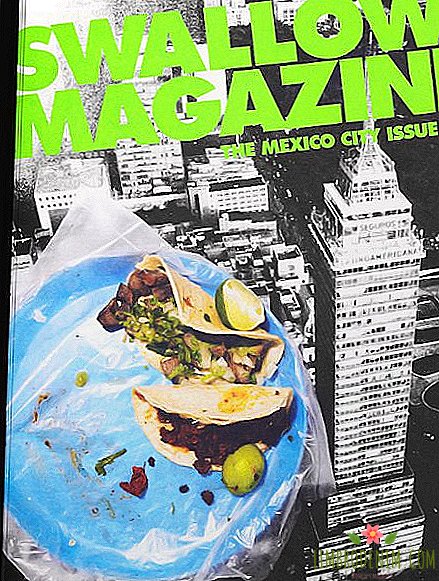13 non-dull food magazines
Reading food magazines is no longer the fate of bored housewives, Martha Stewart and Jamie Oliver fans. The glossy, which occupies a leading position in the culinary sphere, was replaced by independent publications, which brought gastronomy to a whole new level, making it an equally important part of cultural life, like art, cinema, fashion and music. Wonderzine collected the best examples of the modern press, for which food is the main source of inspiration.

Kinfolk
$ 30, US
Kinfolk is published in America once a quarter (the magazine has recently started to appear in Russian) and promotes a way of life in which there is a place for casual meetings with friends, sharing lunch or dinner, as well as unhurried conversations about art, photography and, why not, - about houseplants. The heroes and authors of the magazine are representatives of creative professions, where chefs, florists and cupcake sellers are on a par with photographers, designers and artists. The Kinfolk idea is simple: to create a community of like-minded people for whom food is a pleasant excuse to get together at the same table and recharge each other with creative energy. Kinfolk glorifies everything natural and present, whether it is the traditional recipes of grandma's pie and jam, or photo stories about traveling, hikes and other entertainment of creative gourmets. In addition to the magazine, Kinfolk Community is famous for its inspiring films about food and nature, as well as organizing creative gatherings and feasts in different parts of the world.

Gather Journal
$ 20, US
The Gather Journal was launched last summer and has already become the winner of the James Beard Award in the Visual Storytelling nomination and received two Society of Publication Designers gold medals. The publication is published twice a year, and each issue is devoted to a specific topic. The theme of the third issue was cinema, in particular, the style of directors Alfred Hitchcock and Wes Anderson in a gastronomic interpretation. Like a full-fledged dinner in a restaurant, the magazine is divided into appropriate parts: amyuz bush (from fr. Amuse bouche - a dish of very small size, “for one bite”), snacks, main dish and desserts; as well as special features ("chef's dish") and culinary experiments. According to the founders of the Gather Journal, Michael Outland and Fiorella Valdesolo, their main goal is to bring people together by preparing or eating food together - who like more. The mixtape for the movie number was composed by Cameron Crowe, and on the cover there is a gastronomic reference to the famous Alfred Hitchcock film.

The gourmand
$ 25, UK
David Lane and Marina Tweed, who created The Gourmand Food and Culture magazine, are not professional chefs or restaurateurs, which did not prevent them from becoming culinary trendsetters. Their magazine is a platform for communication, and food is just a reason to start a conversation. Despite the high quality of publications, the couple insists that their magazine was not created to show food as something elite and inaccessible. The Gourmand is an attempt to make food a bringing together and uniting element for readers, it’s rather about the love of food that binds people together. David and Marina deliberately avoid stories about the latest trends in gastronomy and do not interview celebrity chefs: “For us, food is just a catalyst. Our magazine is more about people and processes behind it. We would like even ten years later If you find The Gourmand on the shelf, you would be interested not only to hold it in your hands, but also to read texts and use our recipes. "
These are, rather, not gastro journals, but stylistic, lifestyle-magazines with a bias in gastronomy. In them, for example, very few recipes. And the fact that they suddenly found themselves in a trend did not happen suddenly. Kinfolk, Lucky Peach and Swallow Magazine have been around for several years. And most importantly, these are absolutely marginal low-circulation publications that will never replace magazines for housewives. By the way, marginal gastronomic magazines existed much earlier. For example, my favorite black and white Cook's Illustrated. There are no such magazines in Russia. From the “ours”, Afisha-Food is the closest to them, which differs from the rest of Russian publications, which emphasize photography and the front edge of gastronomy. In any case, it is very nice that they exist. As Anton Utkin wrote the other day, "let all the flowers bloom."

Lucky peach
$ 12, US
If Vice magazine had written only on gastronomic topics, it would have been something like Lucky Peach, the idea of which belongs to David Chang - the chief of the New York noodle Momofuku (hence the name of the magazine - "Happy Peach"). The magazine is published once a quarter, and each issue is devoted to a separate topic, which is explored through articles, photos, notes, art projects and, of course, recipes. The latest issue of Lucky Peach is dedicated to gender issues and is divided into two parts - male and female, which are combined in the middle of the magazine by the Sex section. Chang and his team are not afraid of provocative themes and experiments, turning the notion of gastronomic press on its head. Next to colorful recipes from famous chefs, you can easily find an essay about how American gays prepare food, a study on the role of food and sex in culture, as well as a story of 20 pages without a single advertisement and photographs.

Alla carta
$ 35, Italy
Alla Carta was founded by three Italian creatives from the world of fashion who decided that food is the ideal medium to share their thoughts, opinions and creative ideas. The magazine consists of interviews that are filmed during the day at breakfast, lunch and dinner. The heroes of Alla Carta are successful cooks, restaurateurs and designers who use food to look at various cultural phenomena. When asked why Yara, Fabiana and Valentina decided to make a fashionable magazine with a gastronomic bias, the girls respond that "nothing unites people like a joint meal." On the pages of Alla Carta, the recipes are perfectly harmoniously combined with fashionable shots, for which the publication is deservedly called "the marriage of fashion, food and print design." The magazine is published twice a year in English.

Cereal
$ 30, UK
Cereal is a magazine that comes out once a quarter and, like two peas in a pod, looks like Kinfolk, except that it is printed not in America, but in England. For the rest, the topics of publications and the general style are almost the same: food, nature, travel, inspirational stories about people and products that are found in these travels. Editorial Cereal pays great attention to the aesthetics of the magazine and considers the pleasure of food and travel to be the two most essential elements of a good life. Each chapter of the magazine is devoted to a separate topic or product, which is why it reminds a collection of gastronomic writings dressed in a simple and minimalistic design.
I came to these magazines, oddly enough, through books, blogs and Monocle. That is why they have not so much gastronomic as cultural value. Few would argue that this is a refined aesthetics, well, so be it: we are not talking about food as such, we are about the culture of everyday life. And if we speak from the point of view of the media market and so on, such magazines have an audience. Of course, they are now in the trend and at the peak, but not the fact that it will last forever. On the other hand, the fascination with airplanes at the beginning of the century was also short-lived, and the world changed. In addition to the above magazines, I love the tabs in Monocle and Eatable.

Diner journal
$ 12, US
Diner Journal is a pioneer of the gastronomic press of the new format, published since 2006 under the leadership of Andrew Tarlov, a famous restaurateur from Brooklyn. Diner was almost the first culinary magazine, which contained not only practical advice and recipes, but also made a great emphasis on the intellectual component (essay, author columns and interviews) and invited to cooperate in addition to the food industry first-class photographers, illustrators and writers. A distinctive feature of the magazine is the lack of advertising and a special perforation along the left edge, with the help of which it is easy to store and collect files of the magazine.

Cherry bombe
$ 18, US
Cherry Bombe magazine, unlike the rest of the magazines in this collection, focuses exclusively on the female audience, and all of its characters and contributors are mostly women. Kerry and Claudia, the founders of the magazine, who worked on the American Harper's Bazaar team before creating Cherry Bombe, describe their mission as: reconsidering the role of the woman in the kitchen and changing the idea that the cooking process is hellish work and unfair punishment for the female. For Cherry Bombe, food is an act of self-expression, a creative process and a game. To work on the magazine Kerry and Claudia invite those who grow, cook and study food: cooks, food stylists, farmers, scientists, artists and fashion journalists. The result is a slightly sugary, but very edible cake from fashion, design and culinary art, which will appeal to fans of the films of Sofia Coppola and the famous blog Gwyneth Paltrow Goop.

Put A Egg On It
$ 8, US
The name of the magazine Put A Egg On It is a tribute to the culinary trend, when seemingly simple scrambled eggs became a must-have addition to any dish, whether it be noodles at an Asian eatery or a complex salad in a Michelin-starred restaurant. Put A Egg On It, as mentioned earlier by Lucky Peach, refers to the discharge of a daring culinary press and all its issues are printed on green paper in dollar color and in a format that is unusual for a magazine, resembling a zine rather than a full-fledged print edition. PAEOI is published twice a year and, like other editions of this genre, contains colorful photo reports, illustrations, art projects, essays and essays on cooking and, of course, recipes and practical tips on cooking. Each issue of the magazine is accompanied by a dinner party with a set table, cocktails and dancing until the morning.

Swallow magazine
$ 50, US
Swallow Magazine is one of the brightest independent gastronomic magazines, which has already managed to collect a bunch of prizes and awards for its design and publication. Each issue of the publication is published in a hard cover and is dedicated to a specific geographical area. For example, in order to make the second issue, the journal team set off on the route of the Trans-Siberian express train from Moscow to Beijing, exploring unique culinary traditions and communities along the way. So the whole world learned about our passion for caviar, vodka, dairy products, pancakes, cottage, as well as about who such farmsters are. Despite the fact that due to the emergence of more and more new magazines dedicated to food, it becomes more difficult to stand out in the market, Swallow Magazine editorial still manages to surprise its readers: in the latest issue dedicated to Mexico City, they placed 20 aromatic stickers that literally sense convey the spirit and atmosphere of the city.
It is clear that now only the lazy have no food blog, and certainly everyone reads them. But I am a devoted fan of paper and wouldn’t trade these rustling pages for anything. My personal love is Kinfolk magazine. The guys are very close to us in spirit. They are great at delivering the basic message: food should unite. Unification is very necessary for all of us now. And if this thought is carried by wonderful overseas magazines and they manage to reach out to their audience, then great! Let them be, and let them be as much as possible. But in fact, we are also doing a lot here in order to bring food to a new level, to get away from these thoughtless gatherings in identical cafes with plastic food for inadequate money. Food is not the first year in the trend, and now the most interesting is happening. Everything is going to settle down, and then a new trend will appear, it is already brewing. I really hope that the result of this many years of love for food will be her return to the home and family, to the friendly gatherings at the big tables and to the cozy honest cafes.

Acqtaste
$ 20, US
The name of the magazine Acqtaste is formed from the phrase "acquired taste" - acquired taste. In addition to food, the editors of the Canadian edition are also interested in many topics, including architecture, fashion, music, sports, design, cinema, travel, as well as social problems. But it was the founder of the magazine and the writer Chuck Ortiz who decided to make the main character, because, according to him, he “knows this kitchen from all sides” (Ortiz has come a long way from a waiter on the distribution line to a food blogger). By and large, Acqtaste is a food magazine for matured hipsters who, in addition to gastronomic trends, have become concerned about social issues such as "what happens on farms outside Mexico City" and "who prepares wholesome food in Toronto for disadvantaged women" about which and writes a team log.

Remedy quarterly
$ 8, US
Inspired by her grandmother's scuffed culinary books, designer and food blogger Kelly Carambula launched a project on Kickstarter, with which she collected the necessary amount to publish the quarterly magazine Remedy Quarterly, which was the culmination of her passion for food, design and print art. All editions of the publication are printed with offset in order to preserve the style of cookbooks of the 20th century, and as contributors, Kelly invites not only familiar chefs and food journalists, but also mothers and grandmothers, who share their handwritten recipes and tips on the pages of the publication. The magazine does not contain advertising, and the stories, photo series and recipes of each issue are combined with topics such as "risk", "comfort", "theft" and "legacy".

White zinfandel
$ 20, US
White Zinfandel is a curatorial experiment of the W / - Projects gallery, which has turned into a widescreen publication twice a year and dedicated to a specific gastronomic theme of artistic and historical importance. The work on each issue resembles the preparation for a group exhibition, where in addition to the artists and the curator, there is also a cook who sets the theme for the next publication. Invited artists, writers, architects, photographers and designers explore a given topic, and the result of this culinary and artistic experiment is a joint dinner where they present their works, whether it be a collage, a photo, a drawing, an object or an installation. Despite the complexity of the idea and the unusual format of the publication, White Zinfandel fits perfectly into the category of new art & food magazines, for which food is just a reason to think and talk about something more. "Since art and food are our two biggest obsessions, we thought it would be great to combine them in one project in unexpected ways," the creators of the magazine Dzhimin, Dominik and Chris talk about the concept of the magazine.
Gastronomy magazines, which we are talking about, change the very attitude to food. This is not a step by step instruction, but a source of inspiration. Cooking is cooler than it is! Art instead of gutrobobesiya! British The Gourmand, one of my favorites, loves black and white food photos, after which the legs themselves carry me to the kitchen. I used to cook only buckwheat porridge and soft-boiled eggs, waiting for the invention of tablets that satisfy hunger. And now I can not take my eyes off the oven, in which the dorada that I had just caressed is blushing. The devil knows what it is.
For obvious reasons, the editors could not cover the whole spectrum of this genre, and the article did not include such publications as Meatpaper, Fire and Knives magazine, Chickpea Vegan Quarterly, The Runcible Spoon, Gastronomica, The Art of Eating, Good Company Magazine, Brother Journal and others.




